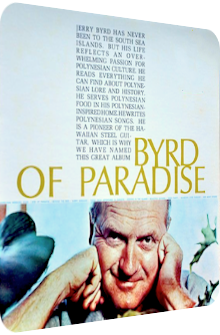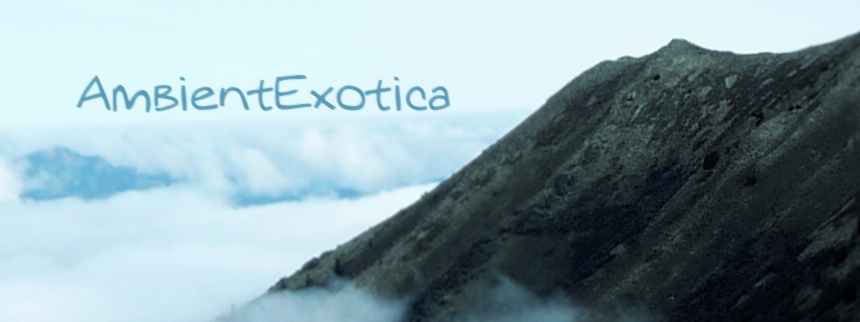
Jerry Byrd
Byrd Of Paradise
1961
To be utterly honest: Byrd Of Paradise by the legendary steel guitarist Jerry Byrd (1920–2005) is an unexpected and largely ignored Exotica gem, and the reasons behind these issues are home-grown. Released in 1961 on Monumental Records, the label mimics the guerilla release tactics of the notorious Crown Records and comes up with three different versions of Byrd Of Paradise, one with a front cover of a Polynesian lady and 12 tracks, one with Jerry Byrd on a light blue background as depicted above and with ten tracks, and finally one with a darker but still brightly blue cover and ten tracks as well. To make matters worse: all three albums share a few compositions, yet have their unique ones respectively. I sincerely hope that this does not destroy the courage of potential listeners to check it out, for the album is superb. Yes, the above front artwork is a tad generic and creepy, but the nine renditions and one unique submission by Jerry Byrd cleverly deceive the listener.
Only recently did I fetch the record off my shelf for review purposes and was blown away, as I never really listened to it. Thinking of it as "one of those Hapa Haole releases," Byrd taught me a belated lesson or two in terms of the arrangements. Firstly, there is a wealth of instruments and related ingredients on board: flutes, triangles, field recordings, mixed choirs, mallet instruments, you name it. Secondly, the percussion scheme is top-notch! Notwithstanding its repetitive groove, the plasticity simply adds much to the conceptions. Bongos, congas, high toms, bamboo rods, maracas and guiros provide a strikingly exotic backdrop. And thirdly, Jerry Byrd is not in the spotlight. His work on the steel guitar is multi-faceted and varied, ranging from elysian euphony over warbled spaciness to droning dreaminess, but in spite of these boundaries and thresholds, he seldom lets the balance of the arrangements out of sight. Read more about one of the Exotica genre's lost steel guitar albums: easily available, rarely considered.
Byrd Of Paradise opens with a tune deemed essential on many a Hawaiian album, and its prominent spot gives it a kind of celebratory note which the intended female audience surely loved: Al Hoffman’s, Charles E. King’s and Dick Manning’s Hawaiian Wedding Song is mandatory and no surprise per se, but arrangement-wise it sure is. The susurrant doo-doo humming of the mixed choir, the diffuse marimba sparks in the background and, of course, Jerry Byrd’s moony steel guitar licks create a dreaminess which draws from more textures than a Hapa Haole trio, but remains sweet and minimal. The following song Bird Of Paradise is written by Jerry Byrd himself and almost letter-for-letter identical to the album title. It is that dob you would not expect! Opening with a tropical field recording of that very bird which is maintained over a large course of this song, leading to both mellow chants of the mixed choir and an entanglement of major and minor tone sequences, the latter of which boost the peaceful loneliness, Bird Of Paradise succeeds with its Polynesian aura, the gorgeous conga globs as well as the almost ethereal steel guitar twangs which reside in earthen, lofty and downright spacey climes. A wonderful tune even without the chirping birds, although these add that certain something which let it tower above like-minded albums.
While Charles E. King’s Forever More is gorgeously arranged and includes prominent congas, raspy croaking guiros, a sun-dried rhythm guitar in tandem with a plinking triangle and a female choir next to Byrd’s prestidigitation on the steel guitar, played here in higher regions, Don McDiarmid’s Evening In The Islands opens with a wonderfully granular-aqueous breeze deriving from shell percussion and Byrd’s distant guitar coils which are washed ashore together with a rather sophisticated and upbeat use of bamboo rods and claves. The mixed choir hums during the first part and sings the lyrics in the second part. A saccharine yet great evening atmosphere. The closer of side A is another magnificently arranged take on the Theme From Adventures In Paradise by Lionel Newman. It kicks off with Space-Age doo-doo chants and finds Jerry Byrd’s malleable and wonky guitar chords united with paradisiac alto flutes and glinting vibraphones. In fact, the luminary's work on the steel guitar is totally nuts in the best way, coated in stardust and galactosamines. A supreme Exotica cut, astutely annihilating the last traces of kitsch thanks to the otherworldly work on that iconic instrument.
Side B opens with the third and last tune from the feather of Charles E. King: Beautiful Kahana feels like a mirage of thermal heat due to its rhythmic structure comprising a bongo- and triangle-accentuated beat which schleps itself forward ever so slowly in adjacency to a hollow high tom, with the choir notably augmenting the hot spell in unison with the polyphonous glitz on the steel guitar. The backdrop is whisper-quiet, the decay and sustain of the instruments induce a particularly cove-like panorama. In stark contrast, Byrd’s take on Jack Pitman’s Beyond The Reef camouflages the nullity with a field recording of gentle ocean waves on the shore and adds a golden-shimmering vibraphone solo to it which then makes room for Byrd’s almost theremin-like elevation regarding his spacey guitar streams. The mixed choir remains on Hawaiian soil, continuing to sing the main melody even when the famous steel guitarist strays away. Of particular success is once more the percussion placenta of sizzling maracas, dreamy bongos and double bass blebs, the latter of which have their most distinct moment in Léon Pober’s vocal-less Tangi Tahiti which launches with shady bass vesicles and mysterious shakers, but then makes a U-turn due to Byrd’s super-dreamy three-note billows. These are tame but glow strongly from within. However, even the marimba cascades cannot mask the fact that this rendition is the most minimal one draped in a soothing nocturnal ambience. The omission of the choir may in fact be its biggest achievement.
The following interpretation of Mel Peterson’s Rainbows Over Paradise is then again situated in broad daylight with a reduced percussion scheme that only comprises of the occasional marimba droplet, tick-tocking drum and triangle scintilla. Even Jerry Byrd plays it safe and warm, which leads me to the choir. Being the signature element in here, it transcendentally floats in-between the song’s microscopic fissures, either singing "rainbows over paradise, rainbows o'er my heart" or melting away incomprehensibly with the gallimaufry of sunbursts, whereas the final Pearly Shells by Webley Edwards and Léon Pober breaks the endemic spell of snugness and sees Jerry Byrd unchain a fast Pop-like percussion scheme in adjacency to the almost Latinized hey-ya chants next to the proper lyrics, shedloads of flute breezes, vibraphone glitz and marimba melodies, with Byrd only making minor appearances. Pearly Shells is the mutant of the album, a picayune ditty about blitheness with an almost funky structure in hindsight.
The explanatory text on the front is as follows: "Jerry Byrd has never been to the South Sea Islands. But his life reflects an overwhelming passion for Polynesian culture. He reads everything he can find about Polynesian lore and history. He serves Polynesian food in his Polynesian-inspired home. He writes Polynesian songs. He is a pioneer of the Hawaiian steel guitar, which is why we have named this great album Byrd Of Paradise." I second every sentence! Byrd Of Paradise is a clever feat, letting the listener think of it as a Hapa Haole work, then luring him or her with field recordings, and once one realizes that the plasticity of the percussion as well as the gorgeous flutes, vibraphones and chants of the mixed choir are literally enchanting, Jerry Byrd has accomplished the various things mentioned in the liner notes; this is a steel guitar album inspired by Polynesia whose structure does not match the sun-soaked Hapa Haole genre, but outshines its folkloristic approach by the means of genuinely transfiguring, carefree and contemplative tone sequences. Byrd's steel guitar would be perfectly suitable in truthful Hawaiiana artifacts, but here its aura gleams differently thanks to the field recordings and many additional instruments.
Jerry Byrd, while being the sole reason for the album's existence and its actual selling point, is only one musician of many. Be it his hands-down superb dexterity on Adventures In Paradise, the close look at the field recording-fueled jungle still life in his unique composition Bird Of Paradise or the strangely glowing moon-lit landscape in Tangi Tahiti, the album would be worse without the many steel guitar protuberances and streams, but it would also be a dud if the session musicians did not partake and nurture the tropical verdure. Fans of Polynesian Exotica records who adore steel guitars and want a more minimal and humble album without brass infusions and string breezes, but at the same time dismiss the jolly blandness of many a Hapa Haole LP have found that rarely mentioned album of snugness: Byrd Of Paradise. The ten-track edition has been remastered and is available as a digital download on iTunes, Amazon MP3 etc., whereas the 12-track version only exists on vinyl as far as I know. I have yet to hear it myself and might hunt it down in a decade or two, as it is not my top priority. I wager that I miss out on some tunes, but I love this incarnation of Byrd Of Paradise enough to feel more than satisfied.
Exotica Review 213: Jerry Byrd – Byrd Of Paradise (1961). Originally published on May 11, 2013 at AmbientExotica.com.
